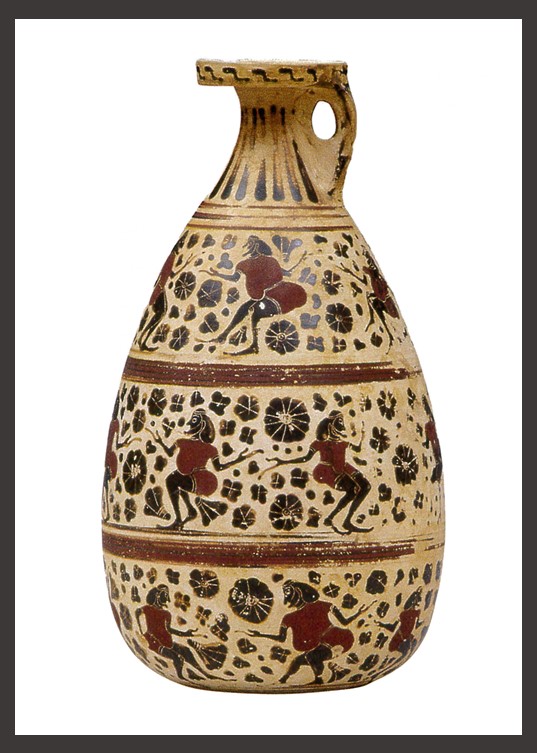
The Paul and Alexandra Canellopoulos Museum in Athens, Greece, is a small treasure trove of outstanding antiquities, showcasing the Museum’s Ancient Art collection spanning from Prehistory to the Roman Era. The collection boasts objects dating back to the Neolithic period (6000-3200 BC), followed by representative examples from civilizations that thrived in the region during the Bronze Age (3000-1100 BC), the Early Iron Age (1100-88 BC), and the Archaic period (7th-6th century BC). Notably, the Archaic period exhibits Corinthian vases adorned with decorative motifs inspired by imaginary beings from the East, such as the Corinthian Arybalos, which I would like to present to you today!
So… Let’s explore the How of an amazing small masterpiece in the Canellopoulos Museum, in Athens… by answering some questions!
How can we best describe the characteristics of the Orientalizing period in ancient Greek Art?
The Orientalizing period in ancient Greek art refers to a significant phase that occurred during the 7th century BCE. It is characterized by a notable influence of artistic motifs and elements from the Near East and Egypt, which were collectively known as the “Orient” to the ancient Greeks. During this period, Greek city-states began to engage in increased trade and cultural contact with the civilizations of the Near East, such as Phoenicia, Assyria, and Egypt. As a result, Greek artists and craftsmen were exposed to new artistic styles, techniques, and iconography, which they integrated into their own artistic expressions.
A key characteristic of the Orientalizing period in ancient Greek art is the adoption of Eastern motifs that included animals like lions and sphinxes, as well as mythical creatures and floral patterns. Greeks, however, were always fond of expressing narrative in their vase painting and they appropriated Near Eastern creatures like the sphinx, for example, or the siren and altered their basic function by making them a part of a larger story. Orientalizing art may look Oriental on the surface but is still recognizably Greek below.
It is important to note that the Orientalizing period was not a homogenous style but rather a phase of artistic transition that laid the groundwork for the subsequent Archaic period. The influence of the Orient on Greek art gradually declined during the 6th century BCE as the Greek city-states developed their own distinctive artistic styles, leading to the flourishing of the Classical period of ancient Greek art. https://www.colorado.edu/classics/2018/06/15/orientalizing-period-ancient-greece
How can we best describe the characteristics of Pottery during the Orientalizing period in ancient Greek art?
During the Orientalizing period in ancient Greek art, pottery underwent significant changes in terms of style, decoration, and iconography. Vessels became more varied and sophisticated, with influences from Eastern pottery shapes and forms. For example, the aryballos (a small, globular-shaped container) and the alabastron (a slender, often pointed bottle) were popular shapes during this time. The period, which occurred from approximately the late 8th century BC to the early 6th century BC, was marked by the influence of Eastern motifs, like lions, sphinxes, and griffins, as well as floral and geometric patterns which became popular, along with the representation of human figures in a more lifelike manner.
How can we best describe the characteristics of Corinthian Pottery during the Orientalizing period in ancient Greek Art?
During the Orientalizing period in ancient Greek art, Corinthian pottery underwent a transformative shift from its earlier geometric style to a more figurative and narrative-focused approach. Influenced by artistic traditions from the Near East and Egypt, Corinthian potters embraced animal motifs, mythical creatures, and composite beings in dynamic poses. Corinthian vessels were adorned with intricate designs, covering the entire surface, exemplifying the abundance and opulence of this period. Utilizing the black-figure technique, they painted dark silhouettes against a yellowish-orange background, embellishing the scenes with incised lines to add detail. To fill empty spaces on these vases, palmettes and lotus blossoms were utilized in place of traditional geometric patterns, and in some cases, negative space gained more prominence.
How can we best describe the Corinthian Alabastron in the Canellopoulos Museum, in Athens?
The Canellopoulos Museum Alabastron from Corinth is typical of the Orientalizing period. This type of pottery, used for holding precious perfumed oils, originated around the 11th century BC in ancient Egypt, and spread via ancient Greece, to many parts of the Mediterranean world. Most Alabastra vases of the Orientalizing period have a narrow body with a rounded end, a narrow neck, and a broad mouth. Alabastra vases were often left without handles, but, for easy mobility, some types were equipped with one, or two, small projections into which holes were punched for strings to pass through, just like the Corinthian Alabastron in Athens.
According to Dr. Moschonesioti… The horizontal rim of the Canellopoulos Museum Alabastro is decorated with a tongue pattern and the vertical side of the rim with broken lines. The neck of the vase is decorated with a tongue pattern and the uppermost part of the vase with three parallel lines. Below them, two wide bands separate three decorative zones with (dancing?) komasts (mythological figures associated with God Dionysus) holding horns. Around the figures, which are presented dressed in purple, floral ornaments, such as large and small rosettes, heart-shaped leaves, and lotus flowers, densely cover the remaining surface of the vase. https://camu.gr/item/korinthiako-alavastro/
The Canellopoulos Museum Alabastro vase boasts an exquisite display of intricate decorations. From the tongue patterns adorning the horizontal and neck rims to the graceful lines and mythological figures of komasts, the artistry captivates the viewer’s eye, standing as a testament to the creativity and craftsmanship of its time.
For a Student Activity inspired by the Corinthian Alabastron in the Canellopoulos Museum, please… Check HERE!